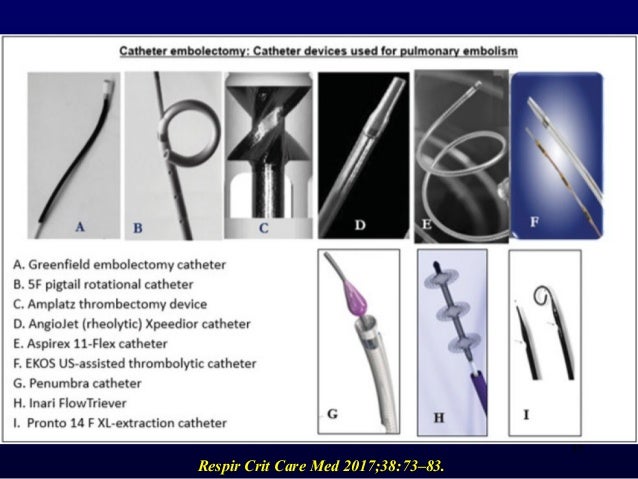Pulmonary Embolectomy Catheter
Pulmonary embolism can be fatal especially in high-risk patients who have contraindications to systemic thrombolysis or surgical embolectomy. We conducted a systematic review of CBT and SE for acute PE.

Transcatheter Pulmonary Embolectomy After Fontan Torok 2016 Catheterization And Cardiovascular Interventions Wiley Online Library
Greenfield LJ Kimmell GO McCurdy WC 3rd Transvenous removal of pulmonary emboli by vacuum-cup catheter technique.

Pulmonary embolectomy catheter. Catheterization of the right heart was first per-formed in 19292 and the first nonselective pulmo-nary angiography was reported in 19383 Selective. While CDL and SPE are generally reserved for patients with higher risk PE there is no expert consensus as to which patients would be best treated by these therapies. Current treatment modalities for PE include systemic anticoagulation systemic thrombolysis catheter-directed thrombolysis CDL catheter-based embolectomy and surgical pulmonary embolectomy SPE.
These include catheter pulmonary embolectomy and thrombofragmentation. However the comparative effectiveness of these approaches is difficult to study. Moore JH Jr Koolpe HA Carabasi RA Yang SL Jarrell BE.
Pulmonary Embolectomy Catheter-based therapies can be rapidly instituted in most medical centers From the Cardiovascular Division Vascular Medicine Section and Cardiac Catheterization Laboratory Brigham and Womens Hospital Boston MA. The former involves the introduction of a suction catheter from a femoral or jugular venotomy through the right heart into the appropriate pulmonary artery under fluoroscopic guidance. Transvenous catheter pulmonary embolectomy is not a covered benefit because it is still experimental.
Acute cardiovascular collapse in the hospitalized patient is associated with a high mortality rate and remains a therapeutic dilemma. Survival could be improved in the subgroup of patients with massive pulmonary thromboembolism if prompt surgical intervention is undertaken. This report presents the.
Embolectomy or catheter thrombectomy. Transvenous catheter pulmonary embolectomy. However the choice is largely based on institutional and physician experience.
For this population interventionalists can provide catheter-directed therapies including catheter-directed thrombolysis and thrombectomy using a wide array of devices. Transvenous catheter pulmonary embolectomy is a procedure for removing pulmonary emboli by passing a catheter through the femoral vein. The technique for the latter involves the percutaneous introduction of a fragmentation catheter from a femoral vein through a guiding catheter.
As soon as the diagnosis is suspected an IV bolus of unfractionated heparin should be administered. See the NCD the Transvenous Catheter for Pulmonary Embolectomy 2406. J Thorac Cardiovasc Surg.
Catheter thrombectomy or surgical embolectomy are alterna-tive treatment modalities to thrombolysis particu-larly in the presence of an increased bleeding risk. Greenfield LJ Pearce HJ Nichols RT. Between October 1999 and May 2015 133 submassive PE patients underwent treatment with pulmonary embolectomy 71 and CDT 62.
The desire to minimize the risk of bleeding events has driven the development of catheter-based strategies for pulmonary reperfusion in PE. Recovery of respiratory function and lung mechanics following experimental pulmonary embolectomy. Accessed July 14 2020 II.
A multidisciplinary PE response team helped to. We report the results for patients who did not qualify for medical therapy and required treatment of submassive PE with surgical pulmonary embolectomy and catheterdirected thrombolysis CDT. Systemic thrombolysis for acute pulmonary embolism PE reduces the risk of death and cardiovascular collapse but is associated with an increased rate of bleeding.
This is a video of a pulmonary embolectomy for a massive pulmonary embolism secondary to a DVT. Pulmonary embolectomy using cardiopulmonary bypass was first reported in 1961 and is now considered to be the best operative technique. Catheter Embolectomy for Acute Pulmonary Embolism Massive pulmonary embolism PE is a life-threatening condition with a high early mortality rate due to acute right ventricular failure and cardiogenic shock.
Systemic thrombolysis catheter-based procedures with or without local thrombolytic therapy and surgical pulmonary embolectomy are procedures that can be used. Both catheter-based therapies CBT and surgical pulmonary embolectomy SE are well-accepted alternatives to treat acute PE. Retrograde pulmonary perfusion was employed as an adjunct to.

Catheter Directed Thrombolysis Of Pulmonary Embolism Thoracic Key

Catheter Based Management Of Pulmonary Embolism

Catheter Directed Thrombolytic Therapy Society For Vascular Surgery

Pe Catheter Embolectomy Page 1 Line 17qq Com